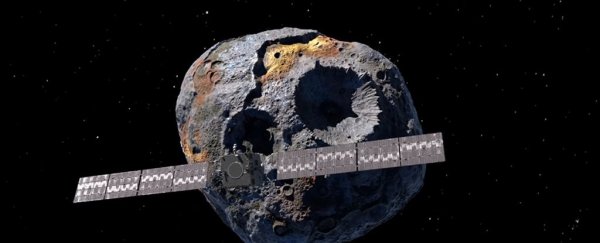It might have just pushed back its manned mission to Mars, but NASA just fast-tracked a planned journey to 16 Psyche - an asteroid made almost entirely of nickel-iron metal.
Estimated to contain $10,000 quadrillion in iron alone, if we could somehow mine Psyche's minerals and bring them back to Earth, it would collapse our comparatively puny global economy of $78 trillion many times over. Fortunately for the economic stability of our planet, NASA plans on looking but not extracting.
"It's such a strange object," Lindy Elkins-Tanton, lead scientist on the NASA mission and the director of Arizona State University's School of Earth and Space Exploration, told Global News Canada back in January.
"Even if we could grab a big metal piece and drag it back here … what would you do?" she adds.
"Could you kind of sit on it and hide it and control the global resource - kind of like diamonds are controlled corporately - and protect your market? What if you decided you were going to bring it back and you were just going to solve the metal resource problems of humankind for all time? This is wild speculation, obviously."
Named after Psyche, a human figure in Greek mythology who earned immortality, 16 Psyche is one of the most massive asteroids that have been discovered in the asteroid belt so far - a dusty disc located between the orbits of Mars and Jupiter.
Measuring 240 km in diameter, it's nowhere near as large as some of the other known asteroids in the belt - the largest, Ceres, has a diameter of 945 km - but 16 Psyche's claim to fame is it is by far the largest exposed iron metal body in the asteroid belt.
If NASA is successful in its mission, Psyche will give humans their first ever chance of exploring a world made of iron - not rock or ice.
The space agency had originally announced that it would be launching its 16 Psyche Discovery Mission in 2023, but has just brought that forward to the summer of 2022.
But the best part is NASA's Psyche probe is now expected to arrive at the metal asteroid four years earlier than initially planned, thanks to the discovery of more efficient trajectory that will get the probe to its destination by 2026.
"We challenged the mission design team to explore if an earlier launch date could provide a more efficient trajectory to the asteroid Psyche, and they came through in a big way," says Jim Green, director of the Planetary Science Division at NASA Headquarters in Washington.
"This will enable us to fulfil our science objectives sooner and at a reduced cost."
It's obviously a bit of a long wait, but it's going to be 100 percent worth it, because we're talking about an object that is entirely unique in the Solar System - an almost naked iron core.
While it's not clear how 16 Psyche has ended up without any rocky or icy coatings, scientists suspect that one or more massive collisions stripped it of its silicate crust and mantle, leaving it with just 10 percent silicate rock on its surface today.
The next question is how the molten core within the now obliterated silicate crust ended up solidifying.
"This mission would be a journey back in time to one of the earliest periods of planetary accretion, when the first bodies were not only differentiating, but were being pulverised, shredded, and accreted by collisions," Elkins-Tanton and her team explained at a conference back in 2014.
"It is also an exploration, by proxy, of the interiors of terrestrial planets and satellites today: we cannot visit a metallic core any other way."
This is going to be an historic mission - and if it somehow opens up the can of worms that is space mining, we're intrigued and excited and terrified all at once.
Can't wait to meet you, 16 Psyche.
